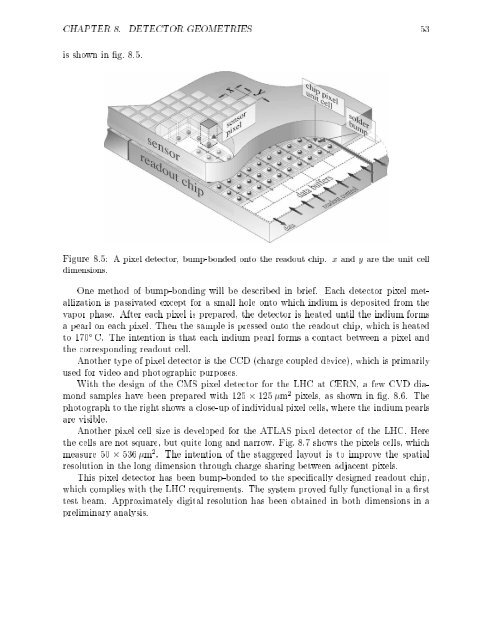Diamond Detectors for Ionizing Radiation - HEPHY
Diamond Detectors for Ionizing Radiation - HEPHY
Diamond Detectors for Ionizing Radiation - HEPHY
Create successful ePaper yourself
Turn your PDF publications into a flip-book with our unique Google optimized e-Paper software.
CHAPTER 8. DETECTOR GEOMETRIES 53<br />
is shown in g. 8.5.<br />
Figure 8.5: A pixel detector, bump-bonded onto the readout chip. x and y are the unit cell<br />
dimensions.<br />
One method of bump-bonding will be described in brief. Each detector pixel metallization<br />
is passivated except <strong>for</strong> a small hole onto which indium is deposited from the<br />
vapor phase. After each pixel is prepared, the detector is heated until the indium <strong>for</strong>ms<br />
a pearl on each pixel. Then the sample is pressed onto the readout chip, which is heated<br />
to 170 C. The intention is that each indium pearl <strong>for</strong>ms a contact between a pixel and<br />
the corresponding readout cell.<br />
Another type of pixel detector is the CCD (charge coupled device), which is primarily<br />
used <strong>for</strong> video and photographic purposes.<br />
With the design of the CMS pixel detector <strong>for</strong> the LHC at CERN, a few CVD diamond<br />
samples have been prepared with 125 125 m 2 pixels, as shown in g. 8.6. The<br />
photograph to the right shows a close-up of individual pixel cells, where the indium pearls<br />
are visible.<br />
Another pixel cell size is developed <strong>for</strong> the ATLAS pixel detector of the LHC. Here<br />
the cells are not square, but quite long and narrow. Fig. 8.7 shows the pixels cells, which<br />
measure 50 536 m 2 . The intention of the staggered layout is to improve the spatial<br />
resolution in the long dimension through charge sharing between adjacent pixels.<br />
This pixel detector has been bump-bonded to the specically designed readout chip,<br />
which complies with the LHC requirements. The system proved fully functional in a rst<br />
test beam. Approximately digital resolution has been obtained in both dimensions in a<br />
preliminary analysis.












